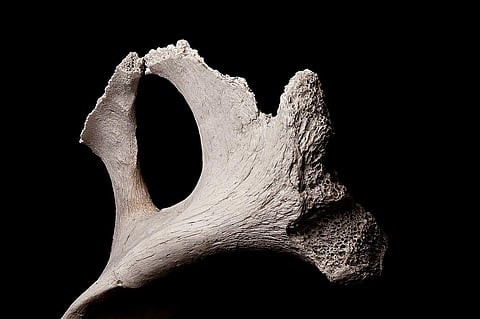

Fossils are time machines that take us back all the way to the geological beginnings of Earth. Simply put, a fossil is any preserved remains, impression, or trace of any once-living thing from a past geological age. These may include bones, shells, exoskeletons, stone imprints of animals or microbes, objects preserved in amber, hair, petrified wood and DNA remnants. The totality of fossils is known as a fossil record, which indicates and depicts a chapter from the natural history of our planet.
There are several ways how fossils form, but most are formed when a living organism (such as a plant or an animal) dies and is quickly buried by sediment (such as mud, sand or volcanic ash). Soft tissue often decomposes, leaving behind only hard bones or shells, however in specific circumstances, the soft tissues of organisms can be preserved. After an organism has been buried, more sediment, volcanic ash or lava may build up over it and eventually all the layers harden into rock, in a process called ‘Lithification’. It is only when the process of erosion, through wind, water, or collapse of the topsoil, occurs that these once-living organisms are revealed from within the rocks. All fossils come from things that lived in a past geological age, and can be as small as a single cell or as gigantic as a complete dinosaur skeleton or petrified tree, and can also include traces of life such as footprints or worm burrows. Fossils are rare to come by, as nature dictates that all living organisms must decay and break down after death.
According to the Australian Museum, common fossilisation processes include:
Permineralisation occurs when dissolved minerals carried by groundwater fill up spaces inside plant and animal cells. The dissolved minerals crystallise in these cellular spaces and eventually form rocks in the shape of the organism
Impression fossils form when the organisms’ original bone or tissue is removed by processes that occur after burial, such as groundwater flow. If the organisms’ remains are decomposed entirely, leaving an empty space in the shape of the organisms, it is referred to as a cast. If minerals fill in this empty space and form a mineralised 3D shape of the organisms, it is referred to as a mould
Amber can preserve organisms if they become trapped in tree resin, which will eventually harden to form a golden amber that has been shown to preserve even 100 million-years-old fossils
Trace fossils record the activity of an organism. They include nests, burrows, footprints and coprolites
Soft tissues can also be preserved. These include the intact remains of organisms, such as preserved skin, muscle, bone, hair and internal organs. Soft tissue fossils form in special circumstances that often need rapid burial and low oxygen environments that stop the organism from decomposing or being scavenged by other organisms. These circumstances can occur when the entire organism becomes rapidly encased in material such as ice or volcanic ash, or buried in peat bogs or trapped in amber
Fossil records help paleontologists catalogue life on Earth over time, helping us retrace our footsteps.